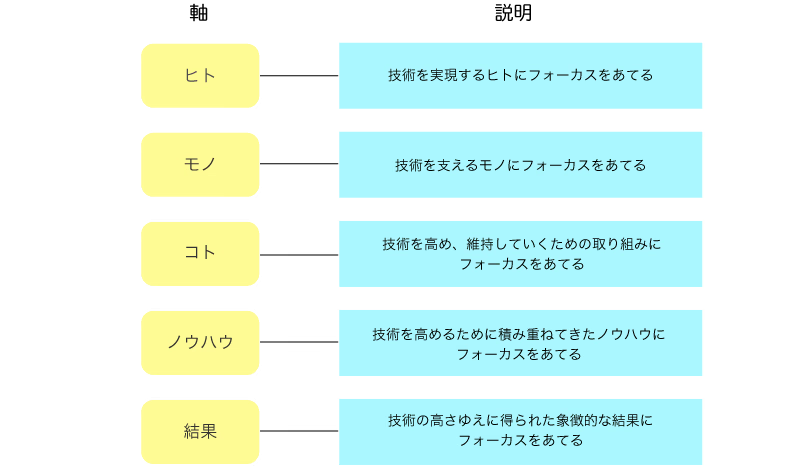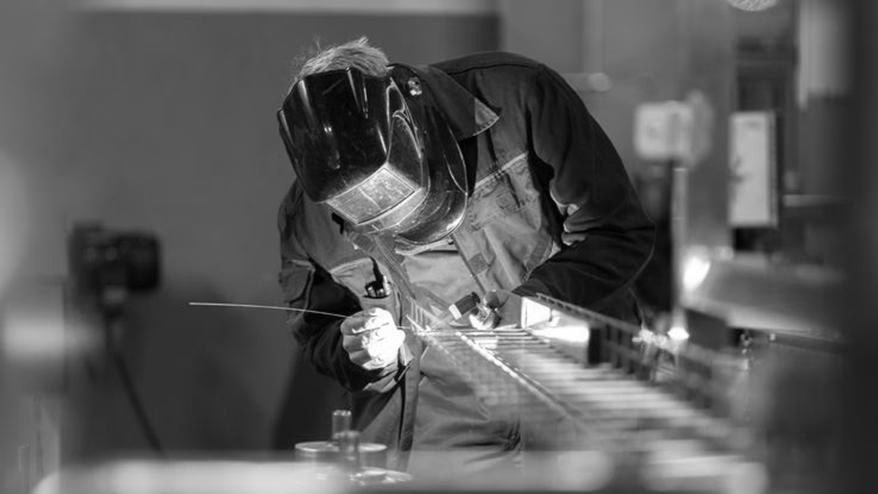こんにちは。BtoB チームの羽賀です。
私たちが、BtoB 企業(特に製造業)の Web サイトリニューアルを進めていくなかで、企業の Web 担当者様からよくお聞きする言葉があります。
「うちの会社には、技術力があります」
実際お話を伺ってみると、世界トップシェアの製品を作っていたり、真似できない独自の強みを持っていたりと、日本には、世界に誇れる素晴らしい技術を持つ BtoB 企業が数多くあると実感します。
しかし、技術力と一口に言っても、その内容は企業によってさまざま。その一言だけでは、「それは本当なのか?」「どんな技術力なのか?」という疑問が生じるのも確かです。
そして技術力とは、ひとつの要素からくるものではなく、いくつかの要素から成り立っている場合が多いのです。
また、その企業の社員の方でも、それをしっかりと認識しているとは限らず、自分たちでは気付いていない部分があるかもしれません。
さらに、認識していたとしても、Web サイトをとおしてユーザーにしっかりと伝え、理解してもらうことは容易ではないのです。
これまで、私たちは「 BtoB 企業のすばらしい技術を、ひとりでも多くの人に伝えたい」という想いから、多くの BtoB 企業の Web サイトを手がけてきました。
では、技術力を伝えるうえで重要なポイントは何か。
Web サイト上でどのように表現すれば、ユーザーに伝えることが出来るのか。
今回は、Web サイト制作において、企業の技術力をユーザーに伝えるコンテンツ作りをするうえで、私たちが重要視している考え方から、実際にどうやってコンテンツに落とし込んでいるのかを、いくつかの切り口とともに紹介していきます。
フレームワークの重要性
私たちが技術力を伝えるコンテンツを作り、それをいかにユーザーに伝えるかを考える際、考え方の軸にしているフレームワーク(枠組み)があります。
そもそも、なぜフレームワークを用いるのか。
その理由は、ある物事について考えるうえで、軸がある場合とない場合とでは、その後の進め方やコンテンツの精度が大きく変わってくるからです。
「技術力とは具体的にどういうことなのか」を見つけだす際、フレームワークを使って企業にヒアリングをし、それをもとにコンテンツに落とし込んでいけばいいのです。軸があることによって考え方にブレが生じにくくなり、一貫性も生まれます。
そこで、これまでのコーポレートサイト制作で培った知見をもとに考えたのが、技術力を伝える際に重要な"5つの軸"です。
<技術力を伝える5つの軸>

よく、経営資源としてヒト・モノ・カネという3つの要素が挙げられますが、この5つの軸は、そこから技術力を伝える考え方として発展させたものです。
続いて、それぞれの軸の内容について説明していきたいと思います。
1. ヒト
まずは、企業にとって無くてはならない"ヒト"という軸について。
企業が成り立つ要素のひとつとして、ヒトの存在が必要不可欠です。ここで言うヒトとは"企業の社員"のことを指します。
そして「どんなヒトが働いているのか」「どんな働き方をしているヒトたちなのか」「どうやってヒトを育てているのか」といった視点から社員にスポットをあてることが、技術力を伝えるうえで重要だと考えます。
例えば、社員へのインタビューや社員同士の座談会から「どこの部署でどんな仕事をしているのか」「どんな姿勢で仕事に取り組んでいるのか」といった部分をユーザーに伝え、技術力を生み出す源である人材について、深く掘り下げたコンテンツを掲載する方法があります。
また、企業独自の社員教育制度やバックアップ体制がある場合、それをコンテンツにして伝えることで、しっかりとした、ヒトの技術力向上の基盤となる制度や体制が社内に存在することが分かります。
2. モノ
次は、技術力を支える"モノ"という軸についてです。
ここで言うモノとは、製品ではなくそれを製造する"設備"を指します。設備がしっかり揃っているということは、良い製品をつくるための土台があるということです。
「どんな設備で製造しているのか」「どんなラインを持っているのか」といった視点から、技術力を生み出す設備を紹介することで、良い製品をつくるための土台が企業に備わっていることを伝えます。
例えば、工場紹介のコンテンツをつくり、工場の設備やラインを紹介します。写真や図解、動画を用いるなど工夫して、文章だけでは難しくなってしまいがちな説明をビジュアルで伝えるといいかもしれません。
また、研究開発や品質検証をしっかりとおこなえる設備のある企業であれば、そういった研究や開発、品質検証を実施している設備を紹介し、環境が整っていることを伝える方法もあります。
3. コト
3番目は、"コト"(=取り組み)という軸です。
技術力を高め、維持していくための取り組みがあった場合、その取り組みの部分にフォーカスを当てます。先ほどの「モノ=設備」が備わっていることを伝えるだけでは完結しません。その設備をどのように生かしているのかというところまでを伝えることが必要です。
「品質を保つためにどんなコトをしているのか」「どんな工程で製造しているのか」といった視点から伝えていきます。
独自の社内プロジェクトや勉強会、研究開発についてのレポートなどをコンテンツとして掲載します。
また、品質検証の仕組みや体制、ワークフロー(生産ラインや研究開発の仕組みなど)を説明していくページがあれば、ユーザーの理解はより深まるでしょう。
4. ノウハウ
続いて、"ノウハウ"という軸について紹介します。
企業がこれまでに積み重ねてきたノウハウや知見にフォーカスを当て、企業の技術力の高さを証明します。それをアウトプットすることが、企業の信頼にもつながります。
「どんなノウハウを持っているのか」「ノウハウをどうやって証明しているのか」といった視点から伝えていきます。
例えば、製品を制作する上でのポイントやノウハウ、業界動向をレポート化し、コンテンツにして紹介します。
企業としておこなっている執筆や講演活動、メディア掲載歴などがある場合は、それを掲載することで豊富なノウハウがあることを伝えることも可能です。
5. 結果
最後の軸は、"結果"です。
ここでは、技術の高さゆえに得られた"象徴的な結果"にフォーカスを当てます。ユーザーに認められるような大きな成果を挙げたことや、技術を活かして作られた作品と呼べるようなものがある場合、それを掲載することが、技術力によって生み出された結果を証明することにつながります。
「第三者からどんな評価を受けているのか」「特に成果が出た事例にはどんなものがあるのか」といった視点から伝えていきます。
例えば、技術に関連する分野で特許を取得していたり、表彰を受けている場合はそれを掲載するとよいでしょう。
また事例紹介も有効ですが、単に事例を並べるのではなく、特に成果が出た事例や技術を生かして作られた作品などがある場合も、しっかり伝えましょう。
最後に
「技術力を伝える5つの軸」、いかがでしたでしょうか?
企業活動においては、ヒトがモノを使ってコトを確立させ、それが蓄積してノウハウとなり、それが結果につながります。それらひとつひとつを分解していき、Web サイトをとおして様々な切り口でユーザーに伝えることが、「私たちは、技術力を持っている」ということの証明につながるのです。
Web 担当者様には、ぜひこの技術力を伝えるための"5つの軸"から自社の魅力を改めて見つめ直し、今後の Web サイト運用のヒントにしていただければ幸いです。
「BtoBならではのWebサイトを追求する」をテーマに
Webサイト制作を中心に様々なサービスを展開しています。
発注前のサポートからサイト制作、公開後の運用まで、
お困りのことがありましたら、ぜひお気軽にご相談ください。
BtoB Webサイト制作サービスについて
お問い合わせ

